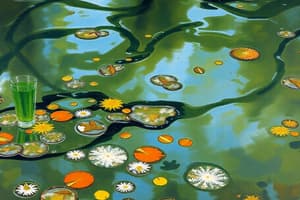Podcast
Questions and Answers
Which statement accurately describes a covalent bond?
Which statement accurately describes a covalent bond?
- Elements give/take electrons to form a strong bond.
- A very weak bond that allows molecules to open/close.
- Monomers in a protein share electrons to make a polymer.
- Elements share valence electrons to form a strong bond. (correct)
What is the pH range for weak acids?
What is the pH range for weak acids?
- 7 to 14
- 0 to 6.9
- 6 to 6.9 (correct)
- 7 to 10
Which of these substances would release the most H+ ions?
Which of these substances would release the most H+ ions?
- Milk with pH = 6
- Hand soap with pH = 10
- Stomach digestive juices with pH = 2 (correct)
- Water with pH = 7
According to the pH scale, which of the following is classified as a strong base?
According to the pH scale, which of the following is classified as a strong base?
Which type of bond is primarily responsible for the properties of water?
Which type of bond is primarily responsible for the properties of water?
What is the term for the attraction between molecules of the same substance?
What is the term for the attraction between molecules of the same substance?
Which property of water allows it to rise against gravity in narrow spaces?
Which property of water allows it to rise against gravity in narrow spaces?
Which of the following compounds does not contain carbon?
Which of the following compounds does not contain carbon?
What is the building block (monomer) of proteins?
What is the building block (monomer) of proteins?
Which polymer is associated with long-term energy storage and insulation?
Which polymer is associated with long-term energy storage and insulation?
Which molecule is considered a polymer made up of many glucose units?
Which molecule is considered a polymer made up of many glucose units?
What characteristic of carbon allows it to form so many different compounds?
What characteristic of carbon allows it to form so many different compounds?
Which of the following statements about enzymes is correct?
Which of the following statements about enzymes is correct?
What hypothesis can be formed regarding the temperature and growth of a lily?
What hypothesis can be formed regarding the temperature and growth of a lily?
In a controlled experiment, which statement correctly describes an independent variable?
In a controlled experiment, which statement correctly describes an independent variable?
Which step comes first in the scientific method?
Which step comes first in the scientific method?
What is the role of controls in a scientific experiment?
What is the role of controls in a scientific experiment?
Which statement best defines a hypothesis?
Which statement best defines a hypothesis?
What is the primary function of nucleic acids?
What is the primary function of nucleic acids?
Which macromolecule is primarily responsible for long-term energy storage?
Which macromolecule is primarily responsible for long-term energy storage?
Which of the following is a monomer of proteins?
Which of the following is a monomer of proteins?
What type of carbohydrate provides structural support in plants?
What type of carbohydrate provides structural support in plants?
Which of the following best describes triglycerides?
Which of the following best describes triglycerides?
Which macromolecule is NOT categorized under the category of lipids?
Which macromolecule is NOT categorized under the category of lipids?
What is the primary function of proteins in the body?
What is the primary function of proteins in the body?
What class of biomolecules do glycogen and starch belong to?
What class of biomolecules do glycogen and starch belong to?
What is the function of an enzyme in a chemical reaction?
What is the function of an enzyme in a chemical reaction?
Which of the following statements about fatty acids is true?
Which of the following statements about fatty acids is true?
What do iodine and brown paper test for respectively?
What do iodine and brown paper test for respectively?
Which of the following correctly identifies the components of a nucleotide?
Which of the following correctly identifies the components of a nucleotide?
What is the role of a buffering agent in a cell?
What is the role of a buffering agent in a cell?
Study Notes
Bonds and Compounds:
- Ionic Bonds: Elements give or take electrons to form a strong bond.
- Hydrogen Bonds: A very weak bond that allows molecules to open/close.
- Covalent Bonds: Elements share valence electrons to form a strong bond.
- Peptide Bonds: Monomers in a protein share electrons to make a polymer.
pH
- Acids: pH 0 to 6.9.
- Bases: pH 7.1 to 14.
- Neutral: pH 7.
Water:
- Polar molecule: Atoms do not equally share electrons causing one side to have a positive charge and the other side to have a negative charge.
- Water mixes with: Polar substances, such as alcohol.
- Water will not mix with: Nonpolar substances, such as oil or benzene.
- Hydrogen bonding: Weak bonds formed between different water molecules.
Properties of Water
- Adhesion: An attraction between molecules of different substances.
- Cohesion: Attraction between molecules of the same substance.
- High Surface Tension: Uneven forces acting on particles on the surface of a liquid.
- Capillary Action: The combined force of attraction among water molecules and with the molecules of surrounding materials.
- High Specific Heat: The amount of energy needed to raise the temperature of 1 gram of a substance by 1 degree Celsius.
Organic Compounds
- Contain Carbon
- Carbon forms four chemical bonds with different atoms
- Carbon is the basic building block of life.
Inorganic Compounds
- Do not contain Carbon.
Macromolecules
- Polymers: Long chains of repeating monomers.
- Monomers: Smaller units that can bind together to form polymers.
Carbohydrates
- Monomers: Simple sugars (monosaccharides) like glucose.
- Polymers: Polysaccharides such as starch, cellulose, and glycogen.
- Functions: Short-term energy storage, structural support in plants.
Lipids
- Monomers: Fatty acids.
- Polymers: Triglycerides, waxes, steroids, fats, oils, phospholipids.
- **Functions: ** Long-term energy storage, cell membranes, insulation, protection of organs.
Proteins
- Monomers: Amino acids.
- Polymers: Polypeptides, enzymes, insulin, hemoglobin, hormones.
- Functions: Regulating chemical reactions, building body tissue.
Nucleic Acids
- Monomers: Nucleotides.
- Polymers: DNA, RNA.
- Functions: Carry the instructions for making proteins, hereditary information.
Enzymes
- Protein catalysts that speed up chemical reactions.
- Specific to a particular substrate due to the shape of their active site.
- Reduce activation energy.
Scientific Method:
- Identify the Problem
- Background Research
- Hypothesis
- Observations
- Experiment
- Conclusion
- Data: Data from an experiment, can be numerical values.
- Controls: Used to compare results, show the effect of the experimental treatment.
- Variables: Anything that can be changed in the experiment.
- Theory: A well-supported set of observations and explanations for natural events.
Studying That Suits You
Use AI to generate personalized quizzes and flashcards to suit your learning preferences.
Related Documents
Description
Explore the fundamentals of chemical bonds, including ionic, covalent, hydrogen, and peptide bonds. Additionally, understand the unique properties of water, its interactions with acids and bases, and the significance of pH levels. This quiz will test your knowledge on these essential chemistry concepts.




